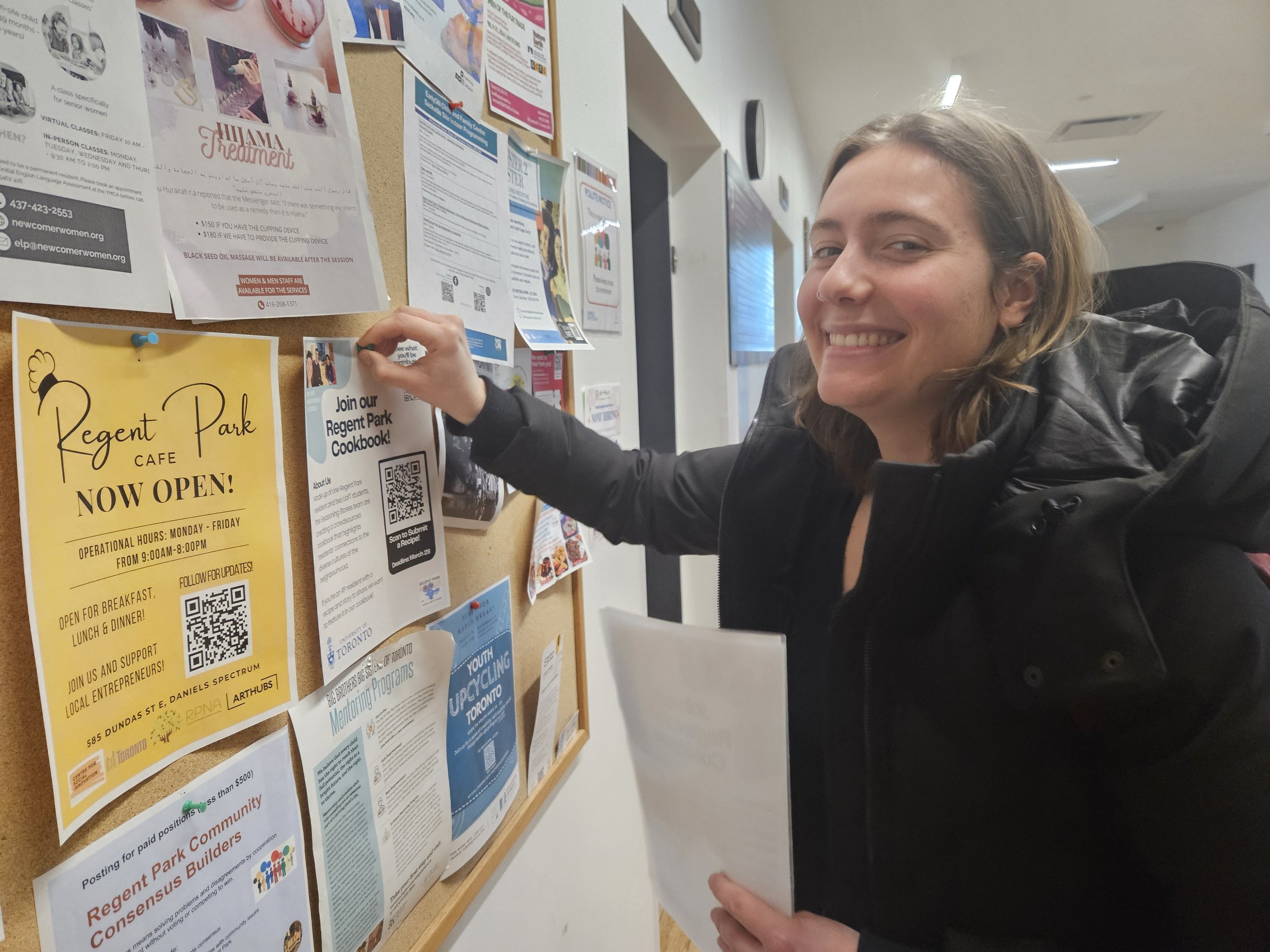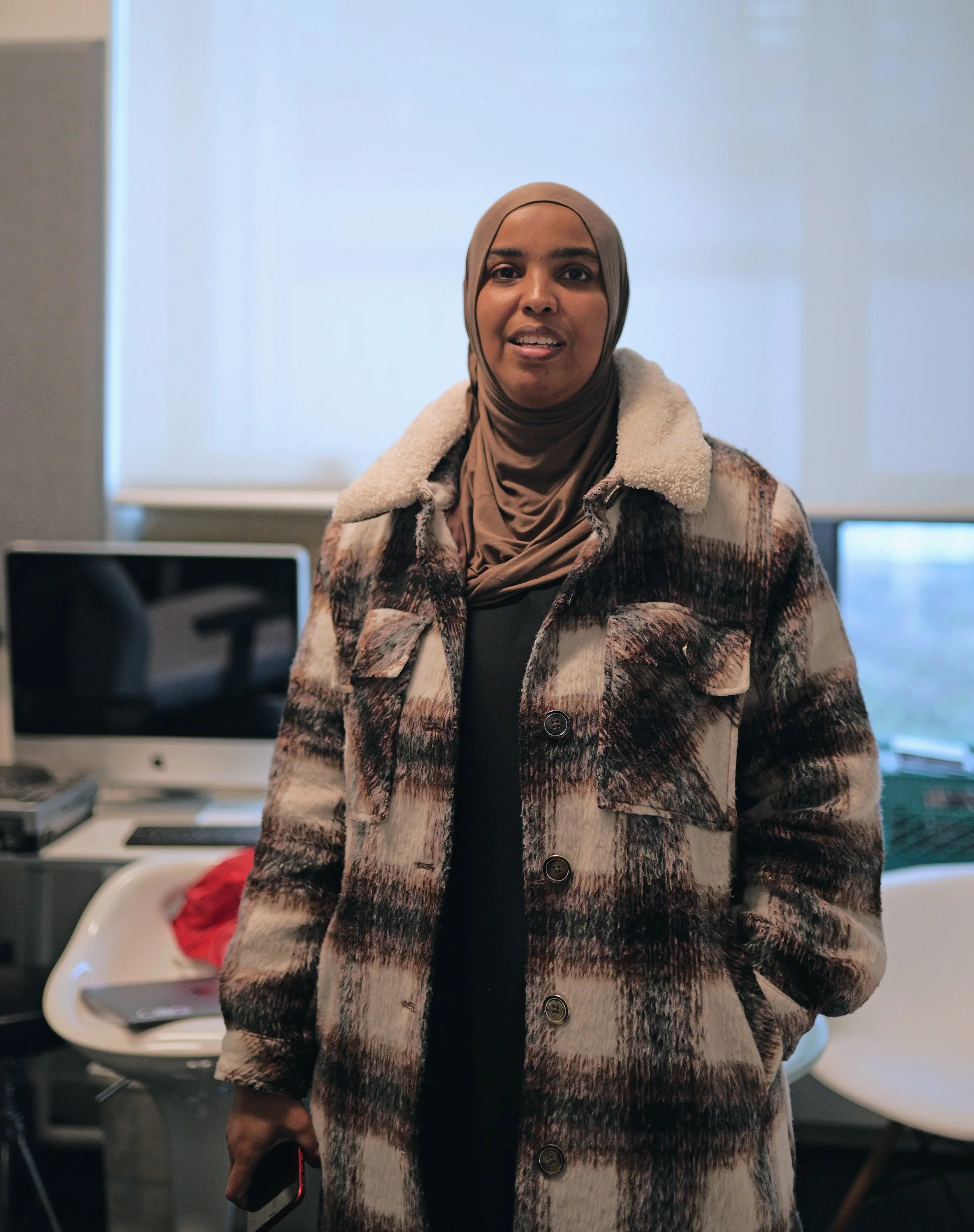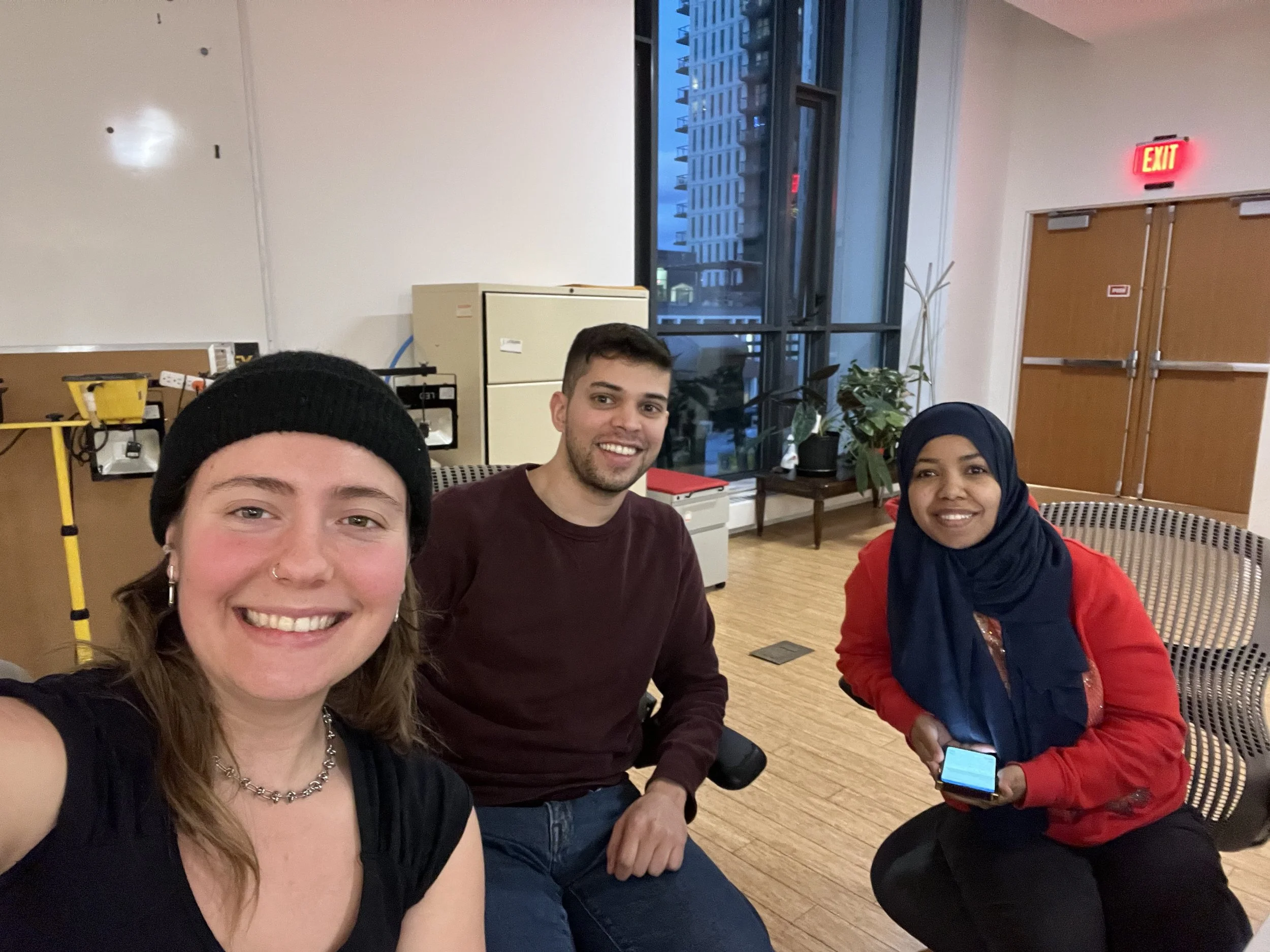Printed copies of the Seasoning Stories cookbook that we created. They are being distributed to contributors and to spaces in the community where they will be accessible to all.
The initial idea of our project, Seasoning Stories was to highlight the diverse cultures of Regent Park by featuring residents' stories alongside their personal, meaningful recipes. Our first two interviews revealed a common theme: sharing food has been a pivotal way for them to forge cross-cultural connections. This led us to our research question, refined over time: How do Regent Park residents use food as a means to bridge cultural differences and forge cross-cultural connections?
Regent Park was once an overwhelmingly Anglo-Celtic neighbourhood that has been transformed through waves of immigration (Rosa, 2019). Today, 71 percent of Regent Park's 12,750 residents identify as visible minorities, compared to 55.7 percent for the entire city’s population, though no one cultural group comes close to being dominant (Statistics Canada, 2023a, 2023b). Regent Park is particularly notable for being nearly one-quarter Muslim; much higher than the city at 9.8 percent.
Traditionally, intercultural studies focus on the interactions between a dominant 'host' social group and an immigrant 'guest' group (Wise & Velayutham, 2009). However, Regent Park is a site of numerous guest-guest relations, which have their own dynamics worthy of study. Our project is an initial attempt to understand the role of food in facilitating these guest-guest connections.
From left to right: Zane Silk, Fathom Alghanmi and Arden Irish; the members of the Seasoning Stories team.
The Role of Food in Facilitating Cross-Cultural Community Relations
Multiculturalism has traditionally been studied at the macro scale, with debates concentrated on the success and failure of policies that attempt to ensure cultural cohesion (August, 2014; Fainstein, 2005). However, a growing field of scholarship focuses on everyday multiculturalism, occurring at the hyper-local level (Wise & Velayutham, 2009). Wise (2009) argues that multicultural neighbourhoods produce contact zones, where people of different backgrounds have the opportunity to build relationships. However, friendly cross-cultural relations in multi-ethnic and mixed-income communities can often face barriers due to linguistic and cultural misunderstandings (Fainstein, 2005; Fumia, 2015). Therefore, when encountering contact zones, individuals use mundane strategies to build relationships across differences, which Wise (2009) refers to as quotidian transversalities.
Kittler et al. (2019) highlight the important role of food in the formation of cultural identity, and conceptualized the term food habits to describe the symbolic way humans appreciate food (Kittler et al., 2019, p. 3). Food habits build specific religious, ethnic, and cultural identities. By sharing food habits amongst themselves, residents of multicultural neighbourhoods can build understanding of their distinct symbolic cultural identities, which is necessary to establish strong interpersonal relationships.
Research Process & Findings
Our participants were all found through a mixture of convenience and snowball sampling. After identifying our research question, we created a semi-structured interview guide to ensure consistency across interviews. The interviews, which were recorded, were conducted in person to minimize miscommunication. We used Otter.AI, an auto-transcription software to make the recordings easier to draw findings from.Our eight participants are all of different ethnicities (see Table 1). We focus on Statistics Canada’s ethnic origins data, as this is the statistic that best allows for comparison between our participants.
Note: Data is adapted from “Census Profile, 2021 Census, 5350031.00 [Census tract] and 5350030.00 [Census tract]” by Statistics Canada, 2023.
aAfiya is an immigrant from Kenya who described her ethnicity as Sawhili. However, the 2021 Census counted 0 inhabitants with either Kenyan or Swahili EO. To gauge the size of the Swahili community, the number of residents with Swahili as a mother tongue has been provided.
We found that, among residents of Regent Park, food forms the basis for establishing and strengthening cross-cultural connections through its central role in everyday practices like gift exchanges, intercultural care, selling of goods and inter-group commensality.
The cases of Gail and Nasreen highlight the importance of gift exchange as a form of quotidian transversality. During the pandemic, Gail decided to try her hand at making non-alcoholic cocktails. With Daniels Spectrum mostly deserted, it was the perfect place for her to practice. As she did so, people would stop by, curious about what she was doing. Gail offered cocktails as gifts, facilitating interactions with people of different backgrounds. Meanwhile, Nasreen’s love for making and sharing food has helped her to build a community network. When she first moved to Regent Park with her family, she would gift food to her neighbours as a way to make new connections. Her neighbours would share food with her in return, and she learned how to make daal and many different kinds of kebab from these friendships.
Mary Ann also engaged in reciprocal gift exchanges. She taught other residents how to make coconut buns at the community bake oven, and they in turn taught her how to make bannock bread and naan, establishing bonds centred on cultural recognition and appreciation.
When practiced cross-culturally, eating together can be a powerful strategy for developing positive relationships (Wise, 2009). Afiya felt isolated upon immigrating to Canada, but she started making connections with fellow mothers when dropping off her son at school. Afiya was soon having potlucks, a form of commensality, with these mothers from countries including India, Pakistan and China. She introduced them to the flavours of her cultural heritage, and in turn learned about and engaged in their customary food habits. These repeated occurrences of mutuality strengthened ties that might have otherwise remained surface-level.
Additionally, cross-cultural connections are established between buyers and sellers. While Ines was already well-established in the community, opening her catering business, GarciaEats, allowed her to make numerous new connections with customers attracted by her empanadas. The Regent Park Cafe is a contact zone where Ines can convey her culture to her community through food habits.
The Cafe also acts as a vehicle for the provision of intercultural care. The women who sell their goods, including Amanda, Gail, Nasreen and Ines, have to work together to ensure that the space is clean and that supplies are maintained properly. They help each other with payment issues and assist with unloading food containers. It is a space of mutual responsibility that allows those from different cultures to “reach across difference without erasing it” (Wise, 2009, p. 34). None of this would be possible without food, which is the reason for the Cafe’s existence.
Another important space of intercultural care is the Regent Park Women’s Social Circle which Fatom and Afiya attend. Fazla, who contributed to our crowdsourced cookbook, makes food every week for all the women. According to Fatom, standing in line while waiting for food is a communal act which allows for conversations across cultural barriers that might make interaction less likely in other situations. “When we get in line to get food we start talking together. It’s a chance to get to talk alone with someone you haven’t seen in a while,” she explains.
Not all residents use food to establish cross-cultural connections. For Veena, food is primarily a tool for showing care and love for her children. However, for the majority of our participants, quotidian transversalities centred on food were essential to the establishment of intercultural ties that they value deeply.
Community Building Through Cookbooks
Capturing these stories in a cookbook is an act of community building and engagement: whether its focus is celebrating cultural food, foraging, healing, or story-telling like ours, cookbooks offer a way of seeing the world (Theophano, 2002). For example, in Ferguson’s (2010) analysis of community cookbooks, he argues that they are a medium for sharing knowledge, identity, and beliefs, among contributors as well as consumers (p. 714). Epp (2015) provides an example of how cookbooks can document immigrant histories in Canada. In the early 2000s, Focus for Ethnic Women, a local organization in Waterloo, created a community cookbook with the mission of showcasing South Asian immigrants, thereby increasing their visibility in the city (Epp, 2015). Modelled after such a framework, our cookbook tells a story of how food is integral for creating contact zones for cross-cultural connection in Regent Park. Our goal is that it can act as a contact zone itself, allowing Regent Parkers to immerse themselves in different lived experiences and food habits. Similarly, although it did not receive as much initial engagement as we had hoped, our crowdsourced cookbook is a way for people to continue to share their stories and food habits with their community.
Read our cookbook here, and check our crowdsourced recipe collection here.
The Seasoning Stories team members are Fatom, Zane, and Arden
Bibliography
August, M. (2014). Challenging the rhetoric of stigmatization: The benefits of concentrated poverty in Toronto's Regent Park. Environment and Planning A, 46(6), 1317-1333.
Epp, M. (2015). Eating Across Borders: Reading Immigrant Cookbooks. Histoire sociale / Social History 48(96), 45-65
Fainstein, S. S. (2005). Cities and diversity: should we want it? Can we plan for it?. Urban affairs review, 41(1), 3-19.
Ferguson, K. (2012). Intensifying taste, intensifying identity: Collectivity through community cookbooks. Signs: Journal of Women in Culture and Society, 37(3), 695-717.
Fumia, D. (2010). Divides, high rise and boundaries: a study of Toronto’s downtown east side neighbourhood. Ethnologies, 32(2), 257-289.
Kittler, P. G., Sucher, K. P., & Nelms, M. N. (2012). Food and Culture (6th ed.). Wadsworth Cengage Learning, USA.
Rosa, V. (2019). Interrogating Multiculturalism and Urban Revitalization: “The Diversity of Diversity” in Toronto’s Regent Park. Journal of Critical Race Inquiry, 6(1), 32 - 61.
Statistics Canada. (2023a). Census Profile, 2021 Census, 5350031.00 [Census tract] and 5350030.00 [Census tract]. Catalogue no. 98-316-X2021001 [Data table].
Statistics Canada. (2023b). Census Profile, 2021 Census, Toronto [Census subdivision]. Catalogue no. 98-316-X2021001 [Data table].
Theophano, J. (2002). Eat my words: Reading women's lives through the cookbooks they wrote. Palgrave Macmillan.
Wise, A. (2009). Everyday multiculturalism: Transversal crossings and working class cosmopolitans. In A. Wise & S. Velayutham (Eds.), Everyday multiculturalism (pp. 21-45). Palgrave Macmillan UK.
Wise, A & Velayutham, S. (2009). Introduction: Multiculturalism and Everyday Life. In A. Wise & S. Velayutham (Eds.), Everyday multiculturalism (pp. 21-45). Palgrave Macmillan UK.












